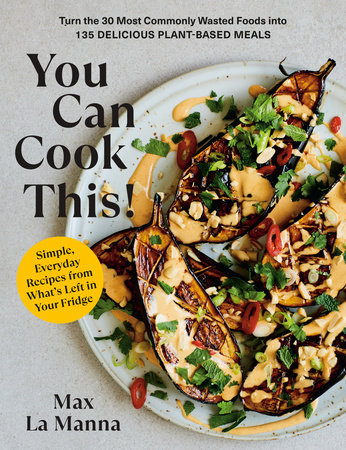Excerpt
You Can Cook This!
Introduction If you ask me what I love the most, I would say to you without hesitation— food (really sorry to my wife; she knows this already, and she’s a close second). I have never been shy to talk about food or my passion for wasting less of it.
First and foremost, my love of food means that I simply enjoy cooking and eating it, and I hate seeing it wasted. However, I grew up in the US, which is without a doubt one of the most wasteful countries in the world, and its throw-away food culture is no exception.
It’s not just pre-packaged fast and cheap food that is treated as disposable: the same ethos is found in high-end restaurants, too. During my time trying to make it as an actor, I worked at an array of restaurants in Los Angeles and New York City, including one with a Michelin star. Food waste was rife at all of them. It pained me.
Once I admitted defeat against my acting aspirations, I turned my focus to championing the food we already have in our fridges and cupboards, and finding exciting new ways to cook the meals we crave the most. I did this in person by hosting dinners for friends, corporate events, and demonstrations, and then later on a digital scale, creating content that is accessible and easy to follow for as many people as possible.
The recipes I’ve created are here to inspire, excite, and transform the way you cook, store, and save food. You may be someone who cooks every day, or perhaps you’re someone who wants to learn or cook more; whoever you are, whatever your motivation, this book is a practical guide, showing you how to develop and cook delicious, simple dishes with the food you already have in your kitchen.
You Can Cook This!—and you probably should! Get in the kitchen right now, explore your fridge and cupboards, uncover the neglected and forgotten ingredients—as long as it’s safe to eat and there isn’t mold growing on it—and cook your way through these pages. You’ll see how effortless it is to create meals using what you already have, and what’s more, they’ll save you money and time.
Why I Wrote This Cookbook Before we start cooking, I need to say a BIG thank-you to those of you who follow me on social media. I asked you for ideas and inspiration; you may recall the question boxes on my Instagram stories that said: “Tell me the food you waste the most,” and from this simple question, I had tens of thousands of responses. Collecting the data, I’ve narrowed it down to the top 30 most-wasted ingredients in your homes. I don’t think you’re going to be surprised by the focus-led ingredients in this cookbook—you’ll already be familiar with most of them. However, I think you may be encouraged by how easy it is to cook these recipes and waste less food.
How This Cookbook Works It’s easier than ever to cook mouth-watering dishes for yourself and your loved ones. This is how it works: all you need is to find an ingredient you want to cook, head to the chapter with said ingredient, and there you’ll find delicious, easy-tocook recipes to choose from. You’ll find further inspiration in the Occasion Index (page 276). These recipes are designed to encourage you to use the entire vegetable, grain, or fruit so that there’s no half-cut, rogue piece of onion or bagged salad wilting and rotting away in your fridge. In this book, there are classics with a twist like my Cauliflower RagÙ (page 146); hearty meals such as Romesco Risotto (page 108); fan favorites like Tofu Butter “Chicken” (page 124) and Crispy Smashed Potatoes (page 36); indulgent sweet recipes, such as Salted Chocolate, Peanut Butter, and Tahini Brownies (page 219) and Carrot Pecan Cake and Orange Drizzle (page 46); comfort food, such as Beet Bucatini (page 30) or One-Pan Lasagna (page 84) and finger-licking snacks—don’t miss my Spicy Baked Cauliflower Wings (page 148) and Loaded Nachos (page 19)!
There’s a disproportionate amount of pressure placed on personal responsibility to create less waste in the world. The majority of this pressure should be redirected and placed on the world’s top 100 most-polluting corporations—who are responsible for 71 percent of greenhouse gas emissions. Not all individuals have the privilege, time, and access to forgo plastic packaging and cook every meal from scratch. With that said, I have firsthand experience of how individual change—with the planet in mind—can benefit our mental health and sense of purpose and community. The more of us aboard this ship, the more positive change we can make.
Enjoy cooking, sharing, and eating delicious food.
—Max




